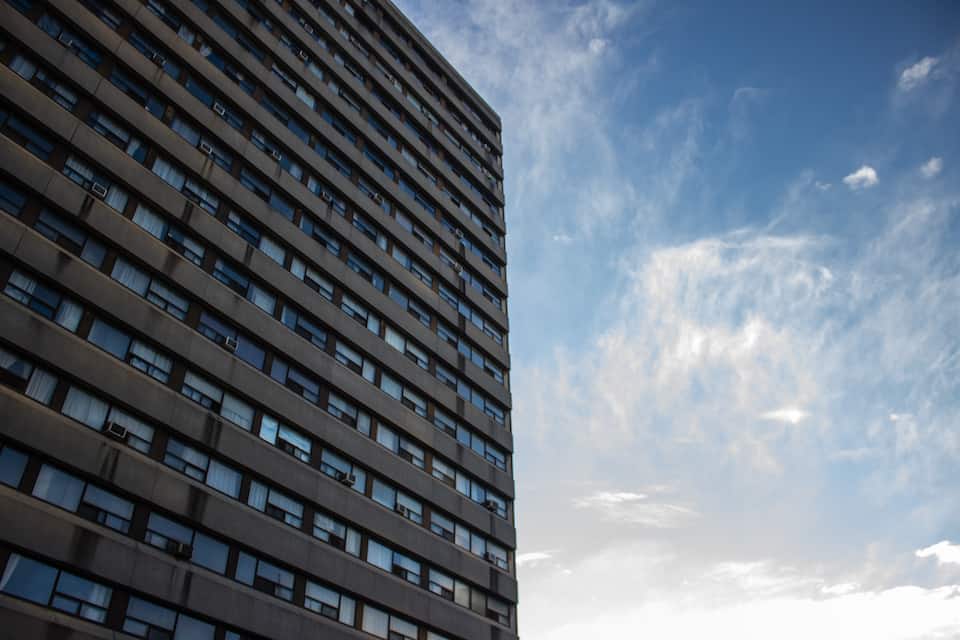[dropcap]A[/dropcap]t some point midway through the seventeenth century, British philosopher Thomas Hobbes aptly pointed out that, “in the state of nature, life is nasty, brutish, and short.” Little did he know that 300 years later, the quote would ring especially true in the context of a controversial educational initiative here in Toronto. Rochdale College, an “experiment in student-run alternative education” located on the outskirts of the St. George campus, aimed to strip bare the constraints of regulated society, and to coexist peacefully as a sub-community with minimal rules and regulations. The institution soon discovered that human beings, in their ungoverned, freest, anarchistic form, are doomed to fail.
341 Bloor St. West is now the home of the Senator David A. Croll apartments, but, midway through the twentieth century, the building was inhabited by an influx of youth intent on participating in an experiment in free education. “Rochdale was founded to be an educational utopia, releasing students and teachers from artificial restrictions and quantitative assessments,” says David Sharpe, author of “Rochdale: The Runaway College.” “That purpose shifted immediately after the doors opened, and became replaced with an organic radical absence of purpose.”
Of the 5,000 residents who called Rochdale home over its seven years, many bought into the optimism of social experiment; in their youthful idealism, residents of Rochdale believed in a free lifestyle bordering, perhaps on anarchy. As such, the college took on a sub-society of its own, fabricating makeshift forms of self-government, policing, and judicial systems within the building. Rochdale even housed its own nursery school, and provided medical care to its inhabitants in the Rochdale Free Clinic. In the college’s early years, there was little reason to leave.
Patrick McDonald arrived at Rochdale in the fall of 1969. He had been working at fisheries in Gaspé, QC in the summer, and was looking for a place to stay in Toronto. Without any knowledge of the Rochdale experiment, he rented out an apartment on the east wing, only to find himself surrounded by hippies.
“I got a job at the Ramsay Wright building working for an animal behavior professor, so it was a very convenient two-block walk,” he says. McDonald and the other Rochdale inhabitants were looking for the “university residence experience.” The apartments were more like dorm rooms, the floors functioned as their own communities, and when it came to paying rent, well, you just kind of ignored it.
McDonald adapted to the college life rather quickly and took up various courses that were offered on the premises. “Japanese [class] was once or twice a week, and so was guitar,” McDonald says. “I took some astronomy lessons on the roof as well.” But, before long, the college took a downward spiral. As Sharpe notes, “these freedom-seekers ranged from profound to profane, from high-minded to simply high.” Many interpreted freedom as the freedom to use, abuse, and deal drugs, and soon rumours surrounding the prominence of illicit activities in Rochdale tarnished the college’s reputation. Tony O’Donohue, the city councilor of the area at the time called Rochdale “an 18 story flop house.”
McDonald recalls “a lady around 40 [years old] who took one of the rooms off the kitchen.” He remembered that she had a drug addiction, but he hadn’t realized to what extent. “One day, she wasn’t around, but we heard her little kitten crying from her room. That was unusual, so we checked the door, and then called emergency services. She took an overdose of something. I believe it was one of her daughters who came to grab her stuff.”
Attending Rochdale College meant that you also had to live in Rochdale College. As Rochdale gained notoriety for its dirt-cheap rent and easy access to drugs, the college’s population increased.
But where did these people come from? Now one of Toronto’s wealthiest, bourgeois neighborhoods, Yorkville was once a hippie-filled, lower class area during the 1960’s. The neighborhood was known to be a hotbed for criminal activity, so when a police raid forced the inhabitants out of Yorkville, many of them fled to Rochdale — thousands jamming themselves into a place designed for only 800. It was then that Rochdale descended into a building full of crime and unruly behavior. A series of suicides, overdoses, police raids, and general rebellion characterized the building as the antithesis to the cultural atmosphere of Toronto at the time.
Dorothy Robertson, an ex-resident of Rochdale who moved into the building after returning from Woodstock, insists that criticisms of Rochdale came from people who misunderstood the college’s purpose. “The average Torontonian believed what they were told,” she says. “They were terrified by this change that they couldn’t understand: the counterculture. They thought what all straight establishment people thought of freaks. We terrified them with our freedom.”
The people initially drawn to Rochdale were the people looking for a sense of community and a sense of purpose outside the typical workday. Looking, as Robertson says, “to find a new way of being, to raise [their] consciousness, to find [themselves] and grow.”
Ultimately, Rochdale was shuttered not because of its illegal goings-on, but because of financial troubles. It was taken over by the City of Toronto and turned into the senator David A. Croll apartments: subsidized housing for seniors. As a token of commemoration, “The Unkown Student” statue sits outside where the college once was. When Rochdale was in operation, the statue faced towards the building, its back to the street — a sort of shunning by Rochdalians of the rest of the world. Today, the statue has been turned to face towards the street. It’s a poetic gesture that serves as a reminder of the building’s turbulent past.


